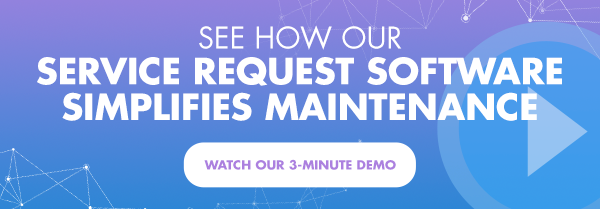How A Facility Maintenance App Supports Your KPIs


Our last post discussed how facility management KPIs have changed along with new expectations for safety, health, and the workplace experience.
You can easily track and improve upon these critical benchmarks with a facility maintenance app.
Here’s how.
What can you track with a facility maintenance app?
Service request KPIs
Service requests are a good indication of what’s working and what isn’t in your workplace. It could be the temperature, the conference room technology, or any number of things. And when there’s a problem, your employees need it to be resolved as quickly as possible. They don’t care whether it’s the facilities team or the IT department — as long as someone is handling it.
With a facility maintenance app, you can assign work orders to the appropriate team quickly. You can see what needs to be fixed and where it’s located on your property.
You can even upload photos and instructions so the person assigned to the request will know exactly what they need to do.
The best facility maintenance apps also connect you to dashboards that track important KPIs, including service requests by type, building, and location.
This allows you to recognize patterns that could be contributing to a poor workplace experience. For instance, if you regularly receive notifications of clogged toilets in a particular restroom, it may be a sign of a bigger underlying issue with your plumbing.
You can identify problems that contribute to poor space utilization, such as a section of the office that is frequently too hot or too cold.
You can also see how your maintenance team is performing across multiple locations.
Preventive maintenance KPIs
If your team has a growing backlog of maintenance requests, you’re not alone.
Fortunately, you can get ahead of these projects by scheduling preventive maintenance and monitoring related KPIs.
Using facility management software, you can set recurring requests to inspect, repair, replace, or maintain key pieces of equipment according to the manufacturers’ guidelines for frequency or usage.
For instance, if you replace all the light bulbs on a floor with new energy-efficient bulbs that last about a year and a half, you can set an automatic reminder for your team to replace them all as they reach end-of-life. This way, you can avoid a host of requests from employees as lightbulbs burn out one by one.
This feature is also handy when it comes to keeping your workspace sanitized to reduce the spread of COVID-19. If you use occupancy sensors, you can even trigger automated service requests each time someone leaves a shared workspace or finishes a meeting in a conference room. This way, your facilities team knows what needs to be cleaned and when, to keep your workspace as safe as possible.
Use your dashboards to keep track of preventive maintenance KPIs, including:
- On-demand repairs compared to preventive maintenance activities
- Total equipment downtime
- Total inventory costs
- Total maintenance costs
This will give your team clear targets for improving and help you demonstrate progress to executives.
Your facility team’s performance
As a facilities leader, you need visibility into how your team is performing and where they may need extra support. Your facility maintenance app should give you the ability to see the details and status of each work order — such as who it’s assigned to and how long it’s been in the queue.
A great app will also provide employees with notifications and updates. When someone can see the status of a ticket they’ve submitted, they’re less likely to pester your team members, which makes the experience better for everyone.
In addition to improving your team’s efficiency, the right technology also holds them accountable.
Keep an eye on performance-related KPIs, including:
- Average service request response time
- Number of requests completed by employee
- Number of overdue work orders
- Total labor hours
How to create dashboards and reports for facility maintenance
To keep up with the demands of the modern workplace, you need real-time data on the requests from your workforce and how your team is responding to them.
Your facility maintenance software should provide performance data at a glance.
You should also have the ability to customize reports and dashboards, depending on your unique needs. For example, maybe you want to know the total labor costs of all repairs for an entire year or quarter.
You may also want to customize the data based on who needs to see it. While you need to know the specifics of each of your team members’ performance, your CEO and CFO only need to know whether total maintenance costs are trending up or down. iOFFICE’s facility maintenance software makes it easy to create custom dashboards and reports for individual users.
You can even email reports to specific people each month or quarter so you anticipate their requests before they ask.
And with a mobile app, you’ll have the data to make better business decisions right at your fingertips.
Ready to improve your team’s efficiency and track what matters most?
